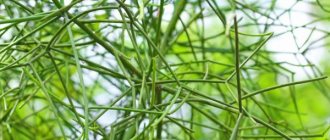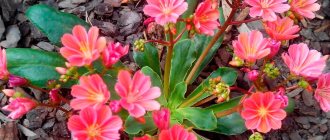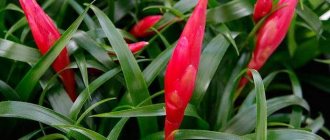Yellow carob sorrel – plant photo, description
• Botanical characteristics, description
Yellow carob sorrel is a medicinal plant, translated as Xantoxalis corniculata (Oxalis corniculata), another name is horned yellow sorrel. This representative of the flora belongs to herbaceous plants, externally it is appressed and pubescent, with an annual tap root. The height of the stem varies from ten to fifty centimeters; it is thin, round, spreading, partially branched, with numerous creeping shoots.
The leaves of yellow sorrel are alternate, trifoliate. The flower arrows at the base are short-segmented, slightly pubescent, two-flowered. Pedicels are up to one millimeter long, the calyx is almost two times shorter than the corolla. The corolla is bell-shaped, it has yellow petals with a straight nail and a deflected blade.
The fruit is in the shape of a cylindrical box, it is slightly pointed, its length reaches two centimeters. Inside it there are ovoid, flat seeds; they are brown or slightly brownish. Horned yellow acid blooms throughout May, June, July, after which it fades.
• Yellow carob sorrel – plant photo
In our country, horned yellow acid is found quite often in forest areas, fields, and so on.
Almost all parts of the plant, namely stems, leaves, roots and flowers, are used for medicinal purposes. This is explained by the presence of many chemical compounds, for example, we can note the presence of tartaric, acetic, citric, glycolic, oxalic, isocitric and malic acid, there is vitamin C, as well as glucose.
• Collection and preparation
To harvest the grass, you can use scissors, after which the raw materials are sorted out to remove unsuitable leaves from the total mass that have darkened or slightly rotted. Then they are placed on a pallet, and they are placed loosely enough to ensure good air circulation; in addition, the harvested plant must be turned over daily.
Next, you need to prepare a container where the dry raw materials will be placed; in this case, you can sew cloth bags from natural cotton fabric, or you can put the grass in paper bags. After which it is necessary to take them to a dry room where the necessary ventilation is established.
Article on the topic: Indian nut - beneficial properties, description
The harvested horned yellow acid herb is used for one year from the date of harvesting, after which it loses its medicinal qualities. Medicinal drugs are prepared from raw materials.
The roots are harvested in this way: first, the soil is shaken off them, then they are washed and placed to dry on a tray, after which they do not forget to turn them over so that they are harvested better. Then they are laid out in cardboard boxes, and the containers with raw materials are placed in a dry room for two years of storage.
• Application of yellow sorrel carob
This plant has the following effects on the human body; it has an anthelmintic as well as an antiseptic effect. Various drugs are prepared from its raw materials, which are often used in the presence of dysmenorrhea and dyspeptic processes. In addition, decoctions and infusions are effective for dysentery; of course, in this situation it would be useful to consult an infectious disease doctor.
In addition to the listed conditions, when drugs are used orally, they can also be used topically as wound healing agents, for example, for furunculosis and purulent wounds. It is worth saying that the juice of yellow acid is effective in the presence of scabies. You can also use it for insect bites, treating the skin in the affected area.
In hot Tajikistan, it is customary to consume fresh horned yellow acid to strengthen the gums. An infusion prepared from the leaves is used as a diuretic and astringent drug; in addition, it is used for fever, as well as for diseases of the liver and gall bladder.
In India, an infusion of yellow sorrel is taken as a remedy that can have a stimulating effect on appetite; in addition, warts are treated with fresh juice, since this procedure affects them negatively, and after a while they completely disappear.
To prepare the infusion, you will need the raw materials of the yellow acid horned, in particular, you need to take its leaves in the amount of 45 grams, then grind the herb of the plant and put it in a container where 400 milliliters of boiling water is poured, after which the container is closed with a lid and the liquid is left to infuse.
Next, you can strain the infusion; to do this, prepare a gauze cloth, fold it in several layers and cover the prepared dishes with it, then pour the prepared potion into it; the settled herbal cake will need to be squeezed out first before getting rid of it.
When the infusion is filtered, you can begin to use it. In this case, it is taken orally before meals, approximately 100 milliliters up to three times a day as a diuretic; in addition, it can be used for hepatitis, cholecystitis, dysentery, and also to increase appetite.
Article on the topic: Amaranth caudate - beneficial properties, description
The drug is stored in a cool place for no more than 72 hours, after which the infusion begins to deteriorate, and accordingly, it will no longer have any positive effect on the body.
Zheltoxidae has medicinal properties, but before preparing any medicinal drugs based on it, it is recommended to consult a specialist.
Features of oxalis
As mentioned above, the genus oxalis includes a large number of species, among which there are perennials, annuals, and also bulbous and tuberous plants. Trifoliate or palmately compound petiolate leaf plates with a complex bend open in the morning and fold in the evening. The foliage also reacts to mechanical irritation or to very bright light. The foliage color can be purple, green or burgundy. Small regular-shaped flowers can be painted pink, yellow, white or lilac. Like the foliage, the flowers close in the evening or before bad weather. Ripe seeds are in a shell that breaks at the slightest touch. Most often, triangular sorrel and four-leaf sorrel are grown indoors. In Europe, indoor oxalis is very often used as a gift under the Christmas tree, because there is such a sign that if such a flower settles in the house 1 day before the New Year, it will bring prosperity and happiness.
Botanical characteristics
An annual herbaceous plant up to 50 cm tall. Grows in meadows, forest edges, sparse forests and bushes.
The root is simple with numerous adventitious roots. The stem is erect, weakly branched. The leaves are opposite, oblong-elliptical, slightly curled, with three pronounced veins, pointed at the ends, entire. The flowers are four-membered, the petals are white, horn-shaped, fused only at the base, and have small spurs. The anthers are yellow, protruding high above the corolla. The flowers are collected in a pyramidal-paniculate inflorescence. Blooms in July, bears fruit in August. The fruit is a capsule, the seeds are numerous, small, smooth, brown.
Care
In the open ground
Oxalis growing in open ground requires moderate watering in summer, every 2 to 3 days during the dry period. To feed sorrel, complex mineral fertilizers and mullein infusion are used. The concentration of the solution for feeding oxalis should be half that for ordinary plants. During the season it is enough to feed 2-3 times. The first feeding is at the beginning of foliage growth, then the second during the budding period, the third – after 2-3 weeks. Oxalis is responsive to feeding and responds to care with lush, overgrown curtains with an abundance of delicate flowers.
At home
An important step in caring for oxalis is to water it abundantly as the soil in the pot dries out. With the onset of autumn, water less often, in winter - to prevent the earthen clod from drying out. Oxalis loves spraying; in spring and summer the procedure is carried out daily, in autumn and winter - without spraying. From April to September, regular (once every 2-3 weeks) fertilizing is carried out with a complex fertilizer intended for indoor plants (halving the concentration). In the fall, feeding is stopped.
Some species of wood sorrel go into a dormant period in winter. If the wood sorrel began to lose leaves after flowering or simply froze and stopped growing, it fell asleep. It is advisable to move it to a room with a temperature of 12-18 degrees. When new shoots begin to grow, return the sorrel to the heat and resume watering and fertilizing. Young oxalis are replanted annually, adults - once every 2 years. The containers are wide, suitable for planting several nodules or bulbs. Transplant the sorrel with a lump of earth into a larger pot, add fresh soil, and water it.
In the fall, wood sorrel that does not overwinter in the open ground is dug up and put away for winter storage. During the growing season, plants form many daughter bulbs that store roots. There is no need to separate nests. The plants are dried for 2–3 days at room conditions, and the remaining leaves are carefully removed. Sprinkle with dry sand or peat and store in a household refrigerator in the vegetable compartment. If storage conditions are not met, the bulbs dry out.
As spring approaches, small oxalis bulbs can be grown in pots by planting them in March - early April and starting watering. Larger bulbs are planted directly in open ground. Oxalis leaves do not tolerate frost at all; they are planted in open ground when the threat has passed.
Oxalis adenophylla - Oxalis adenophylla
Application and medicinal properties
In folk medicine, galenia has long been used as an appetite stimulant and digestive enhancer.
Decoctions of the aerial part of the plant were used as a sedative for neuroses, angina pectoris and other heart diseases.
The polyphenol complex has a pronounced hepatoprotective and antioxidant effect in experimental toxic hepatitis; The aqueous extract in the experiment has protistocidal activity.
In Tibetan medicine, the aerial part of the plant is used for various diseases of the nervous system, gastritis, enterocolitis, jaundice, diseases of the liver and biliary tract, cholecystitis, as an antipyretic, enhances digestion, choleretic and diuretic, and for hypoxia, which has been confirmed experimentally.
Fresh plant juice is effective for loss of appetite and as a choleretic agent. It is also used to remove age spots. Simultaneously inside and outside. Flowers in the form of infusions are used for inflammation of the mucous membranes, for rinsing the mouth to strengthen teeth and treat gums.
Article on the topic: Large nasturtium - beneficial properties, description
Reproduction of Oxalis
The plant, which grows quickly and generously produces new children, is propagated very simply - by daughter nodules. When separating nests during transplantation, they are simply grouped into 8-15 pieces and planted in separate containers, following generally accepted rules.
The plant can also be grown from seeds. Seedlings will begin to fully develop only from the second year, in the first year creating a single rosette of leaves and growing thicker underground shoots (but then the curtains will become overgrown very quickly in the future). Seeds are sown superficially, without covering with soil, in a substrate common for oxalis and moistened with a sprayer. The glass or film is removed as the seedlings grow. In the first year, the plants are carefully moistened; planting is postponed until the seedlings become crowded.
Oxalis that form above-ground shoots, including Ortgis oxalis, also reproduce by cuttings. The shoots are rooted in warmth, at a temperature of about 25 degrees, in clean sand with stable light humidity.











